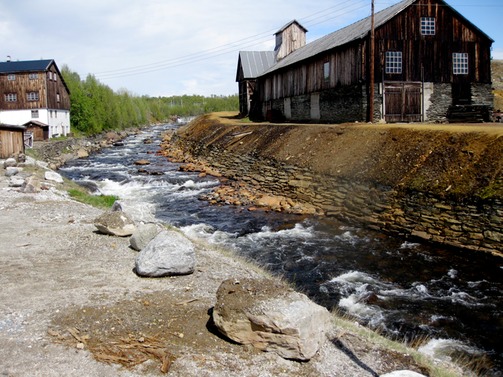Driving Rover in Norway is proving to be easier than driving on the (rest of the) Continent or in Great Britain. The roads are usually a bit wider--and when they aren’t, they’re well paved and have reasonably low speed limits--and parking lots are comparatively huge. We left Lillehammer on the E6. “E” highways are Norway’s version of interstates, but just north of Lillehammer this E becomes two-lane, often with a double yellow line down the middle. There are a few places where one can pull over and let others pass, but the speed limit is usually 50 mph (and brutally enforced to the tune of $700 tickets), with the result that hardly anyone passes.
We had gone 11 miles when we hit our first construction detour. It took us through a couple of small towns and then back on to an E6 that was still very much under construction. We were following a large flatbed truck loaded with large drainage tiles. He pulled over and stopped; we pulled around him. It was about that moment Susan asked David, “Where is the southbound traffic?” Answer: It was coming directly at us on the single lane that wound through the construction zone. When the flatbed truck had stopped, it had been at a red signal light that he was blocking our view of. So within 20 miles of our first outing, we were backing up about 50 yards, pulling over out of the way, letting the southbound traffic pass, and then letting the truck and the other northbound traffic pass us--the light having turned green--after which we pulled in behind them all and continued on our way. Not a good way to start a trip--but it was all easily accompished with great aplomb on our part. And actually it was quite funny.
We got off the E6 and drove east on a smaller road. Even with the occasional 10% grade up and one 12% grade down, it wasn’t difficult, probably because there was virtually no traffic. We drove about 60 miles and met maybe 20 vehicles. For a while we were above the tree line, where snow lingered on the tops on low mountains.

We passed lots of remote campgrounds and stopped for the night in Grimsbu, which appears as a town on the map, but consists only of the campground-with-restaurant, an ancient BP station,

a Joker store (kind of a 7-11) . . . and lots of sheep. At the end of the day, we were blessed with a beautiful rainbow.

The next day we drove on to Røros, stopping on the way in a town with a Vinmonopol. The name is accurate: it’s a state-run store that has a monopoly on the sale of wine and hard liquor. Like any self-respecting monopoly, it sells its goods at very high prices. We bought a 3-liter box of their cheapest wine (the equivalent of four bottles) for $50. Yes, beer can be purchased in grocery stores, but it’s not the same thing.
Røros is a UNESCO world heritage site: a little town built next to and on a slag heap from copper mining, with a very impressive museum in some of the old mining buildings.

A women’s bike race had just ended on one of the main shopping streets in town, so there was a very festive atmosphere with lots of people, and stores stayed open on the pedestrian streets to accommodate us all. We camped in a small field adjacent to a hotel and several soccer fields. So far, campgrounds with electricity have cost nearly $40 a night. But Norway is prosperous and doesn’t need our economic aid, so we will be aiming for a free place when we get to Trondheim.